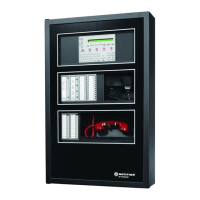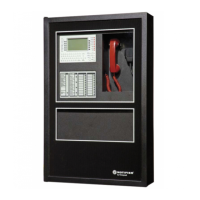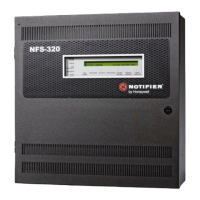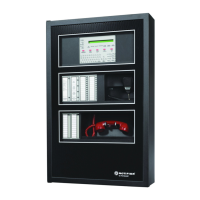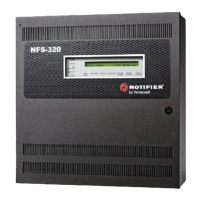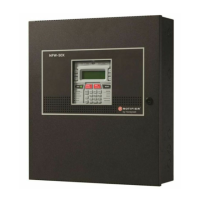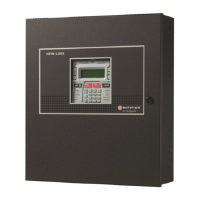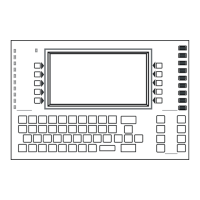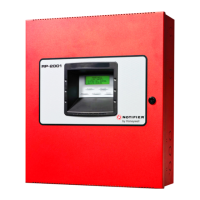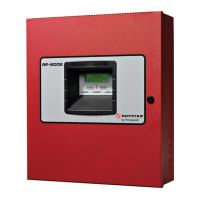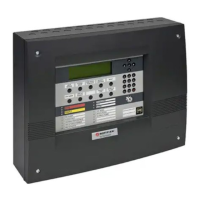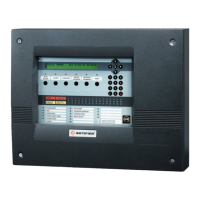Do you have a question about the Honeywell Notifier NFS2-640/E and is the answer not in the manual?
Explains compliance with UL 864 standard for fire alarm systems.
Details manual conventions, cautions, warnings, and notes for clarity.
Lists related documentation and compatible devices referenced in the manual.
Explains keypad shortcuts for accessing various program functions.
Introduces the NFS2-640 as a field-programmable fire alarm control panel.
Outlines key programming features like ease-of-use, autoprogram, and local/PC programming.
Describes the process for entering program change and status change passwords.
Introduces the programming level and its four main options: Basic, Network, Utility, FlashScan.
Provides step-by-step instructions to access the programming mode.
Details options for clearing memory, autoprogramming, modifying points, and changing settings.
Explains how to program network channel thresholds and wiring styles.
Covers options for region settings, reminders, alarm scrolling, and local control.
Describes selecting between CLIP and FlashScan protocols for detectors and modules.
Guides on configuring baud rates for printer and CRT serial ports.
Introduces Status Change mode for adjusting parameters like sensitivity and time/date.
Details the procedure to access the Status Change mode using a password.
Explains how to disable or enable specific detectors, modules, zones, and NACs.
Describes how to adjust alarm and pre-alarm sensitivity levels for detectors.
How to reset counters for detectors undergoing alarm verification testing.
Instructions for clearing the system's historical event log.
Procedure for setting the control panel's internal clock and date.
Covers the process and precautions for performing system walk tests.
Explains the ten Releasing Zones and their independent programmability.
Lists NFPA standards for agent release and preaction/deluge control applications.
Explains setting elapsed time between alarm activation and output device release.
Describes programming different types of abort switches for releasing zones.
Explains how to program zones requiring multiple events for activation.
Details setting the duration for dumping releasing agents after zone activation.
Lists and explains Type Codes for programming releasing zone inputs and outputs.
Explains Presignal feature for delayed alarms and PAS for acknowledged alarms.
Describes how to program outputs and detectors based on time of day and week.
Details selecting pulsed signals for NACs using Special Zone F8.
Introduces Intelligent Sensing software for advanced smoke detection capabilities.
Lists key features like drift compensation, maintenance warnings, and sensitivity adjustments.
Explains algorithms compensating for long-term changes and smoothing noise signals.
Details the three levels of maintenance alerts for detector performance issues.
Describes setting detectors for automatic pre-alarm level adjustment.
Covers selecting alarm and pre-alarm sensitivity levels for detectors.
Explains how detectors share readings for improved alarm decision-making.
Details the function for early warning of fire conditions with Alert and Action levels.
Provides detailed sensitivity levels for various detector types.
Outlines a 90-day testing procedure for high-sensitivity detectors.
Features for viewing and printing detector maintenance status and reports.
Explains CBE as a software function for programming output responses to initiating events.
Describes how input and output devices with CBE-listed Software Zones function.
Details the logic and time delay equations available for programming custom responses.
Explains how to enter logic functions and arguments for equations.
Lists and describes operators like AND, OR, NOT, ONLY1, ANY2, ANY3, XZONE, RANGE.
Provides an example of a complex equation syntax and its components.
Explains the process of evaluating equations to determine TRUE/FALSE outcomes.
Lists valid arguments that can be used within logic functions for equations.
Describes DEL and SDEL operators for implementing delayed operations.
Illustrates how CBE works with monitor and control modules linked to zones.
Explains the automatic detector initialization routine upon detector changes.
Notes that initialization is skipped during Walk Test and how to handle detector replacement.
Provides steps for replacing a detector with a different type and reprogramming the panel.
Details the procedure for manually initializing a detector after replacement.
Defines Type Codes as software selections for device functions.
Explains the process of selecting Type Codes via the Point Programming screen.
Lists the types of Type Codes covered in the appendix.
Covers Type Codes for intelligent detectors and monitor modules.
Lists and describes Type Codes for various intelligent smoke, heat, and beam detectors.
Lists and describes Type Codes for monitor modules used for various functions.
Covers Type Codes for control modules and NACs.
Lists and describes Type Codes for control modules and their functions.
Lists and describes Type Codes for Notification Appliance Circuits (NACs).
| Model | NFS2-640/E |
|---|---|
| Type | Fire Alarm Control Panel |
| SLC Loops | 2 |
| Operating Temperature | 32°F to 120°F (0°C to 49°C) |
| NAC Circuits | 4 |
| Power Supply | 120 VAC, 60 Hz |
| Battery Charger | 4.5 A |
| Maximum Number of Devices | 318 |
| Annunciators | Up to 32 |
| Communication | RS-232, Ethernet |
| Display | LCD |
| Dimensions | 14.5" H |
| Humidity Range | 10% to 93% noncondensing |
